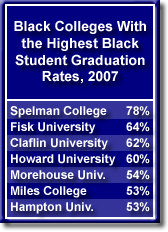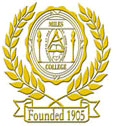Black-White Divide in Cultural Pursuits
A survey published by the National Endowment for the Arts compares the rates of attendance and participation in various cultural activities for blacks compared to whites. In almost all cases, whites were more likely than blacks to attend or participate in these types of events. And in many cases, the differences were large.
For example, whites were three times as likely as blacks to attend a classical music performance, the opera, or the ballet. Whites were twice as likely as blacks to attend a musical play or other type of theatrical production. Whites were also twice as likely as blacks to go to an art fair. Whites were also significantly more likely than blacks to attend a dance recital or an art museum.
The cost of attending these events is undoubtedly one reason for the racial gap in attendance. But money is not the only reason for the cultural gap. This is demonstrated by National Endowment for the Arts data on people who watch these types of cultural events on television. Here, blacks and whites have roughly equal access to the performing arts. And the racial gaps are considerably smaller. But whites are still more likely than blacks to watch classical music performances, plays, ballet, and dance programs on television.


UNIVERSITY OF DAYTON

Director of Career Services
The Position: Reporting to the Associate Provost for Academic Affairs and Learning Initiatives, the Director will provide strategic direction for Career Services and its programs in alignment with the university mission. S/he will oversee the day-to-day management of the Career Services Center (staff of 10), implement career development and planning initiatives for undergraduate and graduate students and alumni, and create networks within and beyond the university community. The Director serves as a key member of the dynamic leadership team, Academic Affairs and Learning Initiatives, and will work collaboratively across the campus and community to develop career programming that addresses the diverse and multicultural values of the University. http://careers.udayton.edu/
Qualifications: The ideal candidate for the position will possess a Master’s degree and at least 5 to 7 years experience with progressively increasing responsibility, preferably in career services, a thorough understanding of current trends in university career services, strong leadership skills, and a demonstrated ability to foster successful collaborative efforts with students, staff, faculty, administrators, alumni, and local, regional, national, and international employers. S/he will have experience in developing programs designed to serve diverse student populations and employers. The successful candidate must demonstrate exceptional written, oral, and interpersonal communication skills.
Review of applications will begin March 5, 2008 and will continue until the position is filled. The University of Dayton is working with Lansing & Associates in this search. Please send resume and letter of interest electronically to margotlansing@comcast.net.
Founded in 1850 by the Society of Mary (The Marianists), the University of Dayton is Ohio’s largest independent university and one of the nation’s ten largest Catholic universities. Diversity is at the heart of the University of Dayton’s Catholic, Marianist mission. The University is an equal opportunity/affirmative action employer. For more information please visit www.udayton.edu.

The Gender Gap in African-American Higher Education: Huston-Tillotson University Is Bucking the Trend
 Black women make up about 60 percent of all African-American enrollments in higher education. They constitute an even larger percentage of African Americans who go on to complete bachelor’s and graduate degrees. Black women make up about 60 percent of all African-American enrollments in higher education. They constitute an even larger percentage of African Americans who go on to complete bachelor’s and graduate degrees.
At the nation’s historically black colleges and universities, black women make up more than 61 percent of all students. At several HBCUs, they are more than 70 percent of all African-American enrollments.
Huston-Tillotson University in Austin, Texas, is the exception to the rule. There, the student body is roughly equal among men and women. But this year, nearly 58 percent of the entering class is made up of men. In the fall of 2004, only 43 percent of the entering class was male.
The university has made a concerted effort to increase male recruitment. It has added majors in scientific fields that it believes will be particularly attractive to black men. And probably most important, it has established a scholarship fund earmarked for black male students.
Racial Controversy at a Christian College in Michigan
Calvin College in Grand Rapids, Michigan, is a Bible college affiliated with the Christian Reformed Church. There are about 4,100 undergraduate students at the college. Only one percent are black.
 The college has a requirement that all faculty members seeking tenure must attend a Christian Reformed Church or a church affiliated with it. Denise Isom, a black faculty member at Calvin, attends the Messiah Missionary Baptist Church in Grand Rapids, which has a predominantly black congregation. She is seeking a waiver of the rule that she attend a Christian Reformed Church, which was founded in Holland and has a predominantly white congregation. The college has a requirement that all faculty members seeking tenure must attend a Christian Reformed Church or a church affiliated with it. Denise Isom, a black faculty member at Calvin, attends the Messiah Missionary Baptist Church in Grand Rapids, which has a predominantly black congregation. She is seeking a waiver of the rule that she attend a Christian Reformed Church, which was founded in Holland and has a predominantly white congregation.
So far the college has refused to budge despite a widespread effort by students on behalf of Isom. One student told the Grand Rapids Press that the college’s effort to appear “distinctly Christian comes off looking like distinctly white.” College officials say they are still seeking a solution before Professor Isom’s contract period ends after the 2008-09 academic year.

UNIVERSITY OF OREGON

Director of the Office of Multicultural Academic Support
The Office of Institutional Equity and Diversity seeks a Director to provide leadership and vision to the Office of Multicultural Academic Support (OMAS), an office that provides a culturally supportive environment that empowers self-identified students of color and students from diverse backgrounds to fulfill their educational goals and meet their potential. The director is responsible for coordinating a variety of multicultural academic advising services designed to enhance student excellence and better ensure successful student outcomes, particularly in the areas of retention and graduation. The director is responsible for supervising OMAS advisors and office support staff, and for oversight of the OMAS budget. This position reports to the Vice Provost for Institutional Equity and Diversity.
A master’s degree in college student personnel, counseling, higher education administration, or related field; experience working in higher education; and three to five years of progressive leadership and supervisory experience are required. The successful candidate will have a demonstrated record of working successfully with faculty, staff and students from diverse backgrounds.
For a complete job announcement with all minimum and preferred qualifications and application procedure, please click here.
To be assured full consideration, application materials must be received by 5:00pm PST on March 17th, 2008, but the position will remain open until filled.
The University of Oregon is an equal opportunity, affirmative action institution committed to cultural diversity and compliance with the Americans with Disabilities Act.

New Full-Tuition Scholarship Program at the University of the District of Columbia School of Law
 The David A. Clarke School of Law at the University of the District of Columbia announced the Advocate for Justice Scholarship program. The program is open to students of all races who have “a proven track record” in their commitment to justice and advocacy. The scholarships will cover full tuition and living expenses at the law school for three years. The law school hopes to award 20 scholarships for the class entering this coming fall. The David A. Clarke School of Law at the University of the District of Columbia announced the Advocate for Justice Scholarship program. The program is open to students of all races who have “a proven track record” in their commitment to justice and advocacy. The scholarships will cover full tuition and living expenses at the law school for three years. The law school hopes to award 20 scholarships for the class entering this coming fall.
While the undergraduate student body at the University of the District of Columbia is predominantly black, African Americans make up only 30 percent of the students at the law school.
Columbia Unveils New Multimedia Web Site on Black History
 State legislatures across the United States are now requiring public schools to integrate African-American history into their regular curricula. State legislatures across the United States are now requiring public schools to integrate African-American history into their regular curricula.
Columbia University’s Center for Contemporary Black History recently debuted a new multimedia Web site that enables K-12 teachers from across America to access and download photographs, maps, images of documents, audio and video clips, and other teaching tools for use in the classroom.
The Amistad Digital Resource is available free of charge. The Web site is divided into 14 key areas including Mississippi Freedom Summer, the Black Arts Movement, voting rights, the Montgomery bus boycott, and the school desegregation effort.
To access this digital resource, click here.
Study Finds That Graduates of Black Colleges Tend to Have Better Jobs But Are Paid Less Than Black Graduates of Predominantly White Universities
 A new study by Terrell L. Strayhorn, an assistant professor in the department of educational psychology and counseling at the University of Tennessee at Knoxville, finds that graduates of historically black colleges and universities tend to have higher status jobs than black graduates of predominantly white educational institutions. But Dr. Strayhorn’s analysis of the occupational status of nearly 72,000 African-American college graduates showed that graduates of HBCUs typically had lower salaries than blacks who graduated from predominantly white institutions. His data, published in the January issue of The Journal of Higher Education, shows that graduates of HBCUs, on average, had salaries that were $3,000 lower than blacks who graduated from universities where the majority of students are white. A new study by Terrell L. Strayhorn, an assistant professor in the department of educational psychology and counseling at the University of Tennessee at Knoxville, finds that graduates of historically black colleges and universities tend to have higher status jobs than black graduates of predominantly white educational institutions. But Dr. Strayhorn’s analysis of the occupational status of nearly 72,000 African-American college graduates showed that graduates of HBCUs typically had lower salaries than blacks who graduated from predominantly white institutions. His data, published in the January issue of The Journal of Higher Education, shows that graduates of HBCUs, on average, had salaries that were $3,000 lower than blacks who graduated from universities where the majority of students are white.
Dr. Strayhorn is a graduate of the University of Virginia, where he also earned a master’s degree in educational policy. He earned his doctorate in higher education from Virginia Tech.

UNIVERSITY OF MINNESOTA

North Star STEM Alliance Program Coordinator
The University of Minnesota Institute of Technology, College of Biological Sciences, and College of Food/Agricultural/and Natural Resource Sciences is accepting applications for the position of Program Coordinator for the Louis Stokes Alliances for Minority Participation (LSAMP) program in Minnesota named the North Star STEM Alliance. The position will also have responsibilities as the Associate Director of the Academic Programs for Excellence in Engineering and Science (APEXES).
The North Star STEM Alliance will broaden the participation of underrepresented minorities in Minnesota in science, technology, engineering, and mathematics (STEM) baccalaureate education. The 18 Alliance partners include Minnesota public and private colleges and universities, community colleges, the Science Museum of Minnesota and the Minnesota High Tech Association. The University of Minnesota Twin Cities is the lead institution in the Alliance formed to address the engagement, capacity, and continuity (ECC) of underrepresented minorities in STEM.
The Program Coordinator will be responsible for planning, developing, and implementing Alliance activities at the University of Minnesota Twin Cities campus that socialize students to STEM studies and STEM careers. The Coordinator will also assist the LSAMP Project Director/Co-PI in the execution and communication of Alliance-wide STEM socialization and professionalization activities. The coordinator will develop and implement initiatives that address the critical STEM education transition points of high school to first year of college, first year to sophomore year, transfer from 2-year to 4-year institution, and from lower division to STEM majors. Major duties include:
- Plan and coordinate academic enrichment activities for Alliance students including peer-to-peer learning initiatives and enrichment learning groups for mathematics, physics, and chemistry.
- Plan and coordinate STEM summer bridge programs on campus, including recruiting of participants and planning of academic and social activities.
- Coordinate industry internships, shadowing, and student professional development activities with corporate alliance partners.
- Coordinate research experiences for undergraduates, including working with engineering research centers, departmental Research Experiences for Undergraduate (REU) programs, and science and engineering librarians across the Alliance to identify research experiences.
- Assist the Project Director of the Alliance with Alliance-wide networking initiatives and activities.
Requirements:
Baccalaureate degree required, advanced degree in STEM disciplines preferred.
- Thorough knowledge of current issues in STEM education for K-12, two year higher education institutions, and four year higher education institutions, especially for populations underrepresented in STEM.
- Experience working with underrepresented populations in STEM, especially in higher education.
- Experience with socialization and professionalization to STEM disciplines.
- Ability to communicate effectively with faculty, staff, and students.
- Excellent organizational/administrative skills.
- Excellent multi-tasking skills.
Apply on-line at http://www1.umn.edu/ohr/employment/index.html
Include a resume, letter of interest, and at least three professional references. Please address not only your interest in the position, but also how you specifically meet the job requirements.
The review of applications will begin no later than February 1. The position will remain open until filled.

Fisk University’s Plan to Raise Funds Dealt a Setback by Tennessee Court
 Judge Ellen Hobbs Lyle of Davidson County Chancery Court in Tennessee has dealt a devastating blow to Fisk University’s plan to raise much needed operating funds. Fisk, the historically black university in Nashville, had reached an agreement to “lend” for six months every year its Stieglitz art collection to a museum in Arkansas. This agreement would have netted Fisk $30 million. The collection had been donated to Fisk in 1949 by artist Georgia O’Keeffe with the stipulation that it be kept intact and not sold. Judge Ellen Hobbs Lyle of Davidson County Chancery Court in Tennessee has dealt a devastating blow to Fisk University’s plan to raise much needed operating funds. Fisk, the historically black university in Nashville, had reached an agreement to “lend” for six months every year its Stieglitz art collection to a museum in Arkansas. This agreement would have netted Fisk $30 million. The collection had been donated to Fisk in 1949 by artist Georgia O’Keeffe with the stipulation that it be kept intact and not sold.
In Memoriam
Vera Joseph Peterson (1909-2008)
 Vera Joseph Peterson, the former director of the Smith College Health Service, died late last month in Springfield, Massachusetts. She was 98 years old. Vera Joseph Peterson, the former director of the Smith College Health Service, died late last month in Springfield, Massachusetts. She was 98 years old.
A native of Jamaica, she came to the United States in 1919 through Ellis Island. She graduated from the New York City public school system and won a scholarship to Barnard College. After graduation she enrolled in the medical school at Columbia University.
For a time she taught medicine at the American University of Beirut and worked in the public health programs of a number of international organizations. In 1964 Dr. Joseph returned to the United States to accept a position with the Smith College Health Service. She retired from this position in 1975.
Grants
• Three historically black universities — Claflin University in Orangeburg, South Carolina, North Carolina A&T State University, and the University of the District of Columbia — were among 14 educational institutions selected to participate in the Undergraduate Science Research Program sponsored by Merck Inc. and the American Association for the Advancement of Science. The universities will receive three-year grants totaling $60,000 to support undergraduate research collaborations between the biology and chemistry departments at each university.
|
African-American Student Graduation Rates at Historically Black Colleges and Universities
 The graduation rate of African-American students at the nation’s historically black colleges and universities (HBCUs) tends to be much lower than the graduation rate for black students at the nation’s highest-ranked institutions. Money is necessary to stay in college. Many of the private HBCUs have puny endowments and therefore are not able to offer adequate financial aid packages. The graduation rate of African-American students at the nation’s historically black colleges and universities (HBCUs) tends to be much lower than the graduation rate for black students at the nation’s highest-ranked institutions. Money is necessary to stay in college. Many of the private HBCUs have puny endowments and therefore are not able to offer adequate financial aid packages.
Nevertheless, the graduation rate at a significant number of HBCUs is well above the nationwide average for black students, which currently stands at an extremely low rate of 44 percent.
By a large margin, the highest black student graduation rate at a historically black college belongs to Spelman, the academically selective, all-women’s college in the city of Atlanta. At Spelman, 78 percent of entering students graduate within six years.
Fisk University in Nashville, Tennessee, has the second-highest graduation rate among the black colleges. At Fisk, 64 percent of the entering black students go on to graduate within six years. Claflin University in South Carolina has a black student graduation rate of 62 percent. Hampton University, Miles College, Howard University, and Morehouse College, sadly, are the only other HBCUs that graduate at least half of their black students within six years.
  |
 “African-American history is American history. The integration of African-American history into the public school curriculum strengthens the quality of education for all students.” “African-American history is American history. The integration of African-American history into the public school curriculum strengthens the quality of education for all students.”
— Manning Marable, professor and director of the Center for Contemporary Black History at Columbia University, announcing the launch of a new multimedia Web site on black history (See story below.)
|
Harvard’s Henry Louis Gates Debuts Online News and Opinion Magazine
 Recently a new online news magazine with a focus on African-American issues called The Root was launched by The Washington Post. The online magazine includes daily news updates on issues deemed important to African Americans as well as commentary, opinion pieces, and Web blogs. Recently a new online news magazine with a focus on African-American issues called The Root was launched by The Washington Post. The online magazine includes daily news updates on issues deemed important to African Americans as well as commentary, opinion pieces, and Web blogs.
Henry Louis Gates Jr., Fletcher University Professor and director of the W.E.B. Du Bois Center for African and African American Research at Harvard University, serves as the editor in chief of The Root. Lynnette Clemetson, a former foreign correspondent for Newsweek magazine, runs the day-to-day operation as managing editor.
Readers interested in sampling The Root can do so by clicking here.
Black Faculty in the Biological Sciences
 Data collected by Donna J. Nelson, an associate professor of chemistry at the University of Oklahoma, finds that there are 101 black scholars teaching in the biological sciences at the 100 universities with the largest research budgets in the field. These 101 black biologists make up only 1.4 percent of all biology faculty at these 100 research universities. Sixteen of the 101 black biologists teach at Meharry Medical College, the historically black medical school in Nashville. There are 14 black biologists at the University of Texas Medical Branch and nine black biologists at the University of Florida. There are four black biologists at Yale, Cornell, and Michigan State University. Data collected by Donna J. Nelson, an associate professor of chemistry at the University of Oklahoma, finds that there are 101 black scholars teaching in the biological sciences at the 100 universities with the largest research budgets in the field. These 101 black biologists make up only 1.4 percent of all biology faculty at these 100 research universities. Sixteen of the 101 black biologists teach at Meharry Medical College, the historically black medical school in Nashville. There are 14 black biologists at the University of Texas Medical Branch and nine black biologists at the University of Florida. There are four black biologists at Yale, Cornell, and Michigan State University.
Of the 101 black biologists at these 100 large research universities, 26 are women. Thirty-five black biologists hold the rank of full professor at these 100 institutions.

UNIVERSITY OF NORTH CAROLINA WILMINGTON

Assistant or Associate Professor of Elementary Language and Literacy Education
Assistant or Associate Professor of Elementary Language and Literacy Education to join our Department of Elementary, Middle Level, and Literacy Education in August, 2008. Requirements include: Doctorate in language and literacy or related field, eligible for or currently hold the rank of Assistant or Associate Professor, a record of scholarly productivity, evidence of teaching excellence, eligible for North Carolina licensure in the appropriate area and a strong commitment to B-12 partnership approaches. Experience with diverse learners, supervision of teacher interns, and use of current technology is desirable. Program information available at http://www.uncw.edu/ed/emlle/elementary/index.html
Review of applicants will begin March 21, 2008 and continue until the position is filled. For more information and to apply, please visit the Web at http://consensus.uncw.edu.
UNC Wilmington is an EEO/AA employer.

The Resurgence of Miles College
 Twenty years ago, enrollments at Miles College, the historically black educational institution in Fairfield, Alabama, near Birmingham, had dwindled to about 400 students. Money was tight, and to many observers it seemed like the college would have difficulty surviving until the 21st century. Twenty years ago, enrollments at Miles College, the historically black educational institution in Fairfield, Alabama, near Birmingham, had dwindled to about 400 students. Money was tight, and to many observers it seemed like the college would have difficulty surviving until the 21st century.
But Miles College made a dramatic comeback. There is now a record 1,800 students at the college. And the college hopes to increase enrollments to 3,000 over the next several years.
A major boost was the acquisition of a 40-acre parcel of land adjacent to campus that was the site of Lloyd Noland Hospital, which has closed. The acquisition doubled the size of the Miles College campus. The college plans to demolish the old hospital building and build a new performing arts center on the site. Also, the new grounds will house a school for international politics, a physical education facility, and a child development center.
The college is in the midst of a $30 million fundraising campaign to pay for the expansion. To date, more than $24 million has been raised, mostly from area corporations and foundations.
  |
48% Percentage of all black households where the head of household had a college education that had broadband access to the Internet in 2005.
70% Percentage of all black households where the head of household had a college education that had broadband access to the Internet in 2007.
source: Pew Internet & American Life Project
|
New Report Defines the Role of the Chief Diversity Officer in Higher Education
 A new report from the American Council on Education provides a template for university administrators on the duties and the role of a chief diversity officer. Authored by Damon A. Williams, assistant vice provost at the University of Connecticut, and Katrina C. Wade-Golden, a senior research scientist at the University of Michigan, the report provides a blueprint that helps define the role the chief diversity officer should play at an institution of higher education. Williams hopes that the report “makes a contribution that higher education leaders can innovate from as they develop dynamic diversity capabilities at their respective institutions.” A new report from the American Council on Education provides a template for university administrators on the duties and the role of a chief diversity officer. Authored by Damon A. Williams, assistant vice provost at the University of Connecticut, and Katrina C. Wade-Golden, a senior research scientist at the University of Michigan, the report provides a blueprint that helps define the role the chief diversity officer should play at an institution of higher education. Williams hopes that the report “makes a contribution that higher education leaders can innovate from as they develop dynamic diversity capabilities at their respective institutions.”
The report, entitled The Chief Diversity Officer: A Primer for College and University Presidents, can be purchased for $25 at the council’s Web site by clicking here.
New Academic Program at North Carolina A&T State University
Beginning this coming fall, North Carolina A&T State University, the historically black educational institution in Greensboro, will offer a new degree program in atmospheric sciences and meteorology. It will be only the second degree program in meteorology at a black college.
 The establishment of the degree program was possible under a $12.5 million grant from the National Oceanic and Atmospheric Administration. The university hopes to enroll 20 students in the program this fall. The establishment of the degree program was possible under a $12.5 million grant from the National Oceanic and Atmospheric Administration. The university hopes to enroll 20 students in the program this fall.
In 2006, fewer than five African Americans earned doctorates in the atmospheric sciences.

NORTH AMERICAN COUNCIL FOR ONLINE LEARNING (NACOL)

Registration is now open for the Virtual School Symposium (VSS) 2008
The North American Council for Online Learning (NACOL) is pleased to announce that registration is now open for the Virtual School Symposium (VSS) 2008. This year's conference will take place October 26-28, 2008 in Phoenix, Arizona. The VSS theme is: "Bridging the Gap through Online Learning"
The VSS 2008 Program Committee is now accepting proposals for presentations at the conference. The deadline for submitting proposals is March 31, 2008. To download the directions and application, please visit: http://www.virtualschoolsymposium.org/rfp.php or go through NACOL’s website at http://www.nacol.org.
The VSS brings together more than 1200 education leaders from national, state, district, private and other programs together at the industry’s leading event in K-12 online learning. The VSS conference provides important networking opportunities, access to expertise and analysis, trends, research and thought-provoking sessions for leaders looking to help shape the future of education.
Early bird registration discounts are available for a limited time! NACOL members can register by Sept. 15th for only $369.
About NACOL
The North American Council for Online Learning (NACOL), founded in September 2003, is the international K-12 non-profit organization representing the interests of administrators, practitioners and students involved in online learning in the United States, Canada, Mexico, and abroad.NACOL’s mission is to increase educational opportunities and to enhance learning by providing collegial expertise and leadership in the K-12 online teaching and learning marketplace. The association strives to achieve this mission by leading initiatives to conduct research to enhance quality K-12 online learning; encourage collaboration among practitioners in the online learning marketplace; and promote the success and effectiveness of online learning. NACOL offers monthly Teacher Talk Webinars on the third Thursday of each month at 6:00 p.m. (Eastern). Registration available with member and non-member pricing to individuals and institutions.

New Scholarship Program for Black and Hispanic Women Returning to Higher Education to Study Science or Medicine
 AMBI skincare products are marketed to women of color by Johnson & Johnson. The company recently announced the establishment of the AMBI Scholarships in Science and Medicine program. The scholarships are available to African-American and Hispanic women interested in pursuing careers in the sciences or medicine. The $10,000 scholarships are for nontraditional students seeking to continue their academic careers. Applicants must demonstrate financial need. AMBI skincare products are marketed to women of color by Johnson & Johnson. The company recently announced the establishment of the AMBI Scholarships in Science and Medicine program. The scholarships are available to African-American and Hispanic women interested in pursuing careers in the sciences or medicine. The $10,000 scholarships are for nontraditional students seeking to continue their academic careers. Applicants must demonstrate financial need.
More information on the scholarship program can be obtained by clicking here.
Black Applicants Surge at the University of California
 As has been the case with most of the nation’s highest-ranked universities, the number of freshman applications has increased significantly this year. Systemwide, applications to the University of California are up 9 percent from a year ago. As has been the case with most of the nation’s highest-ranked universities, the number of freshman applications has increased significantly this year. Systemwide, applications to the University of California are up 9 percent from a year ago.
But the number of black applicants to the nine undergraduate campuses of the University of California is up 16.1 percent. Over the past two years, the number of blacks applying to the University of California has increased by more than 26 percent.
At the University of California at Berkeley, the most prestigious campus of the system, there are 1,984 black applicants this year, an increase of 9.4 percent from a year ago. At UCLA, black applicants are up 12.9 percent. The most dramatic increase was at the University of California at Santa Barbara. There, the number of black applicants rose from 1,292 in 2007 to 2,084 this year, an increase of 61.3 percent.
It is important to remember that all applicants to the University of California are considered without regard to race.
Bush Administration Takes Aim at CUNY’s Black Male Initiative
 The U.S. Department of Education informed the City University of New York that it has launched an investigation into the university’s Black Male Initiative to determine if the effort is discriminatory against women or any racial or ethnic group. The U.S. Department of Education informed the City University of New York that it has launched an investigation into the university’s Black Male Initiative to determine if the effort is discriminatory against women or any racial or ethnic group.
The Black Male Initiative was instituted university-wide in 2005. Its goal is to increase, encourage, and support the inclusion and educational success of under-represented groups in higher education. The university states that the program is open to all students without regard to race or gender. The initiative is funded with taxpayer dollars.
The program was based on a program initiated at CUNY’s Medgar Evers College in 2001. That effort has shown success. There were 1,044 black male students on the Medgar Evers campus in 2003. This year there are 1,371, an increase of more than 31 percent.
Wellesley College Increases Student Financial Aid
Wellesley College, the selective college for women in Massachusetts, has joined the growing list of high-ranking colleges that have increased their financial aid offerings. All students from families with incomes below $60,000 will have their student loans replaced with scholarship grants. About 30 percent of Wellesley students come from families with incomes below $60,000.
Students on financial aid from families with incomes between $60,000 and $100,000 will have their debt load reduced by one third. For all students on financial aid, there will be a four-year cap of $12,825 for total debt incurred while at Wellesley.
The new financial aid program at Wellesley will bring the college’s total budget for student assistance to about $40 million.
Blacks make up 5 percent of the student body at Wellesley College.
Appointments
 • Carmaletta Williams was appointed first executive assistant to the president for diversity initiatives at Johnson County Community College in Overland Park, Kansas. Williams has been a professor of English at the college. • Carmaletta Williams was appointed first executive assistant to the president for diversity initiatives at Johnson County Community College in Overland Park, Kansas. Williams has been a professor of English at the college.
Williams holds bachelor’s and master’s degrees in English from the University of Missouri-Kansas City and a Ph.D. in English from the University of Kansas.
Awards
 • David E. Jones, community development educator at New York University, was named the Outstanding New Professional of the Year by Region II of the National Association of Student Personnel Administrators. • David E. Jones, community development educator at New York University, was named the Outstanding New Professional of the Year by Region II of the National Association of Student Personnel Administrators.
Jones is a graduate of Eastern Connecticut State University. He holds a master’s degree from the University of South Florida.
Earl Lauer Butz, R.I.P.
 Earl Butz, who served as secretary of agriculture from 1971 to 1976 under Richard Nixon and Gerald Ford, has died at the age of 98. Earl Butz, who served as secretary of agriculture from 1971 to 1976 under Richard Nixon and Gerald Ford, has died at the age of 98.
Butz was a highly educated yet an inept man. Before accepting a Cabinet appointment in Washington he served as dean of education at Purdue University.
Butz is perhaps best known for being forced to resign after telling a racist joke on an airplane following the 1976 GOP convention in Kansas City. Entertainer Pat Boone had asked Butz why the GOP had trouble attracting black voters. Butz replied, “The only thing the coloreds are looking for in life are tight pussy, loose shoes, and a warm place to shit.”
This was the end of Butz’s career in public service. When news of the remark was widely reported in the press, Butz resigned. Five years later, Butz pleaded guilty to federal tax evasion charges.
|
 .
.